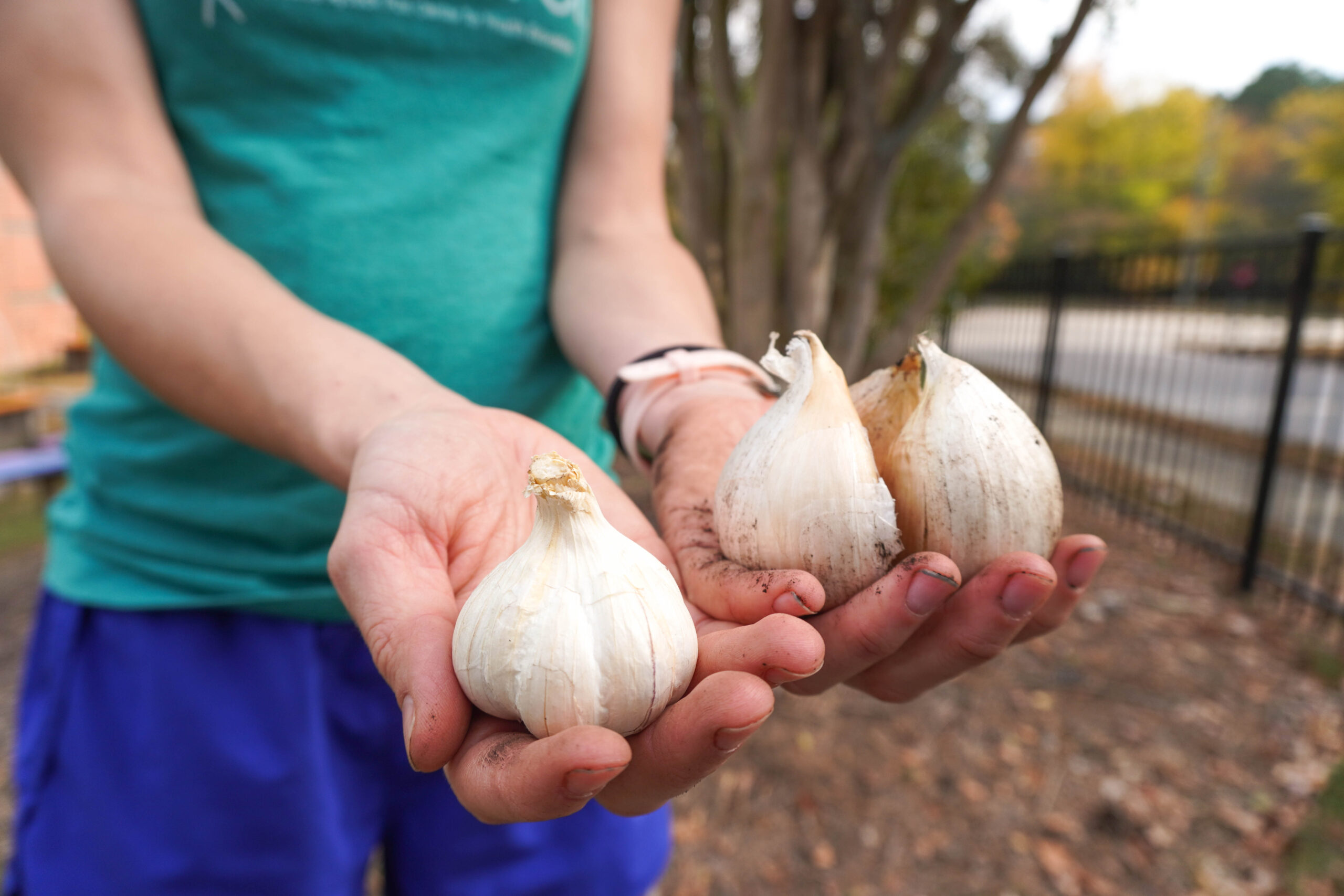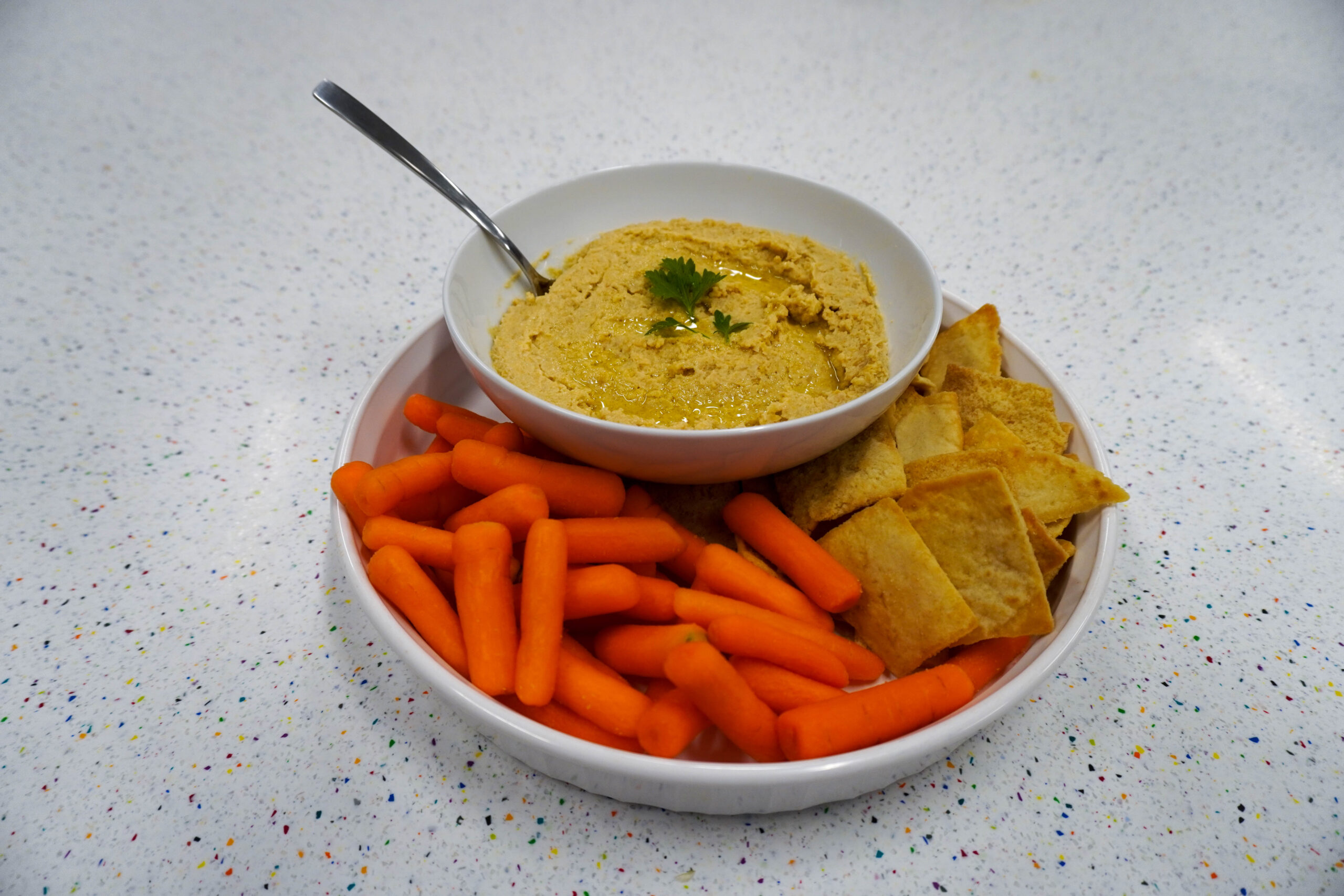
How to Plant Garlic & Make Hummus
Anna Glasgow, MAT
Garden Senior Specialist
Katie Barker, RD
Health Educator
Garlic is a universally-loved ingredient that is used by people all over the world. Garlic’s nutritional benefits make it a great addition to many dishes. It is also one of the easiest plants to grow in your home garden. Winter is the perfect planting season for garlic.
Planting seasons may vary depending on your planting zone. Since the Poe Center is located in central North Carolina, we plant in Zone 8B. To find your planting zone, go to https://planthardiness.ars.usda.gov/
Tips for Growing Garlic
Garlic grows best in full sun in well-drained, fertile, loamy soils with a soil pH between 6.2 and 6.5. It’s a good idea to plant garlic in an out-of-the-way spot that you can leave undisturbed for 6 to 7 months. Planting in pots or containers works well because you can move them around easily. Garlic takes about 6 to 7 months to reach harvest so if you plant your garlic in December, expect to see delicious heads of garlic ready for harvest in early summer.
There are many varieties of garlic. The two main categories are “hardneck” garlic and “softneck” garlic. Hardneck varieties have large cloves that are easier to peel, while softneck garlic varieties have braidable stems and tend to store better. In this video, Anna plants both Duganski and Elephant varieties. Duganski is a hardneck variety with purple stripes, known for a deep, rich flavor with earthy undertones. Elephant garlic is technically not a true garlic; it is more closely related to leeks. Since Elephant garlic has similar growth habits, it can be treated and grown like any other variety, and is thus referred to as garlic. To ensure a bountiful harvest, be sure to buy seed garlic at your local plant nursery instead of using garlic from the grocery store.
Roasted Garlic Hummus
Hummus first originated in the Middle East and made its way to Greece and other parts of the Mediterranean. Hummus is not always used as a dip, but is considered a part of the main dish. In the Middle East, you can find hummus served with lamb, beef, or pita bread.
This recipe features chickpeas, which are a great source of plant-based protein. They are high in fiber which keeps you full for longer. They are also high in zinc, a mineral that is important for mental health, brain health, and the immune system. Chickpeas, also known as garbanzo beans, are a staple ingredient in Mediterranean cuisines. This recipe also features garlic, which is anti-inflammatory, great for gut health, and adds flavor to low-sodium foods.
Ingredients
1 head garlic
4 Tablespoons Extra-Virgin Olive Oil, divided
One 15.5–ounce can chickpeas, drained and rinsed
Juice from 1 lemon
2 Tablespoons tahini
3/4 teaspoon salt
Optional garnish: chopped parsley or cilantro, and more Extra-Virgin Olive Oil for garnish

Instructions
- Preheat the oven to 350ºF. Rub papery skin off the whole head of garlic.
- Cut off the tip of the head of garlic with a serrated knife, exposing a cross-section of garlic cloves.
- Lay root side down on a sheet of aluminum foil or in a small baking dish. Drizzle 2 Tablespoons of oil over the cut end of the garlic head. Crimp foil closed or cover the baking dish with foil.
- Roast until the garlic is soft and fragrant, about 45 minutes to 1 hour.
- After removing from the oven, open foil and let sit until cool enough to handle.
- Squeeze the garlic cloves out of the papery skin. Discard skin and transfer cloves to a food processor or blender. Pulse a few times until slightly chopped.
- Add the remaining 2 Tablespoons oil, chickpeas, lemon juice, tahini and salt. Purée or blend until completely smooth, about 1 minute, or more as needed. Serve sprinkled with sumac and parsley, or drizzled with more olive oil if desired.
Notes
Hummus will keep covered in the fridge for up to 4 days.
Follow our Garden to Kitchen blog each month for great tips
and insights on growing and cooking edible plants:
Get this great content delivered directly to your inbox.
Subscribe to our monthly nutrition email newsletter.
